Play Critically was provided with a review code for this videogame.
Mighty Goose is a side-scrolling arcade shooter about Mighty Goose, an interplanetary mercenary goose. Mighty Goose is equipped with powered armor that lets them run, jump, and gun through nine levels across multiple worlds in peril. Backed up by a team of anthropomorphized animal mercenaries, Mighty Goose fights to stop the VOID Army and their king from using a combination of alien parasites, dark magic, and military prowess to conquer the solar system.
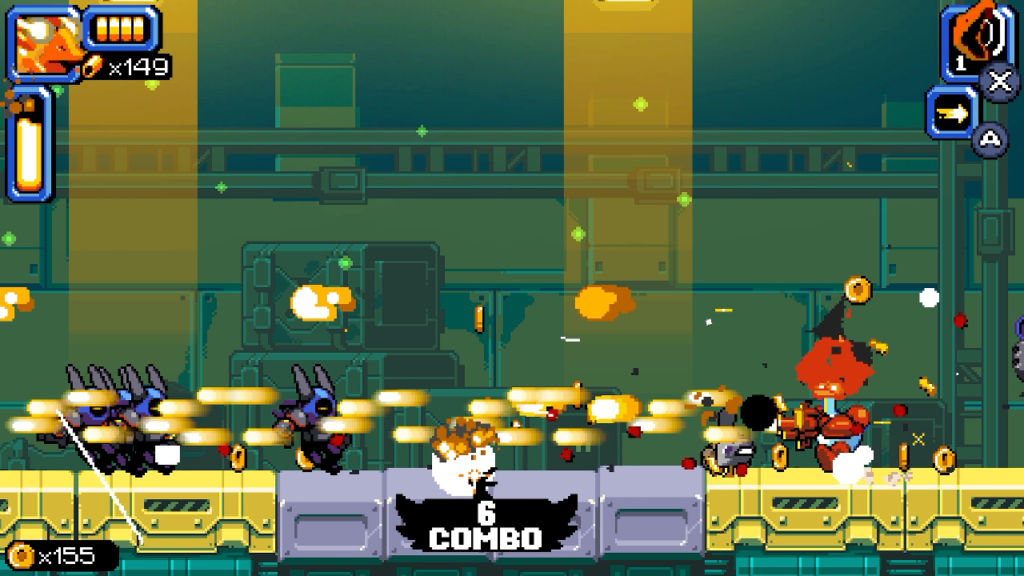
In a setting filled with bipedal, talking animals, Mighty Goose is an enigma. They give the impression that without their powered armor they would be an ordinary goose. I can even make Mighty Goose emit a great “honk!” with the press of a button. The character’s central appeal is that in an extraordinary setting, they are especially ordinary. What caused Mighty Goose’s benefactors to confer upon an un-charismatic and un-capable fowl the powered armor that transforms them into a formidable videogame protagonist remains a mystery. In typical arcade style, the specific details about Mighty Goose’s settings are left tantalizingly unexplored.
Mighty Goose is also faithful to its arcade roots in its game design. I guide Mighty Goose from one side of a level to another, shooting the dozens of VOID Army soldiers who get in my way. I discover powerful weapons as I run through the levels, and Mighty Goose always has access to a pistol with a bottomless clip when the big guns run out of bullets. Yet even when I’m forced to fall back on this sidearm, I’m never stalled by an enemy for more than a few seconds. In typical arcade fashion, Mighty Goose remains focused at all times on moving forward into new scenarios where I shoot at new things. If I’m standing still, then something is wrong.
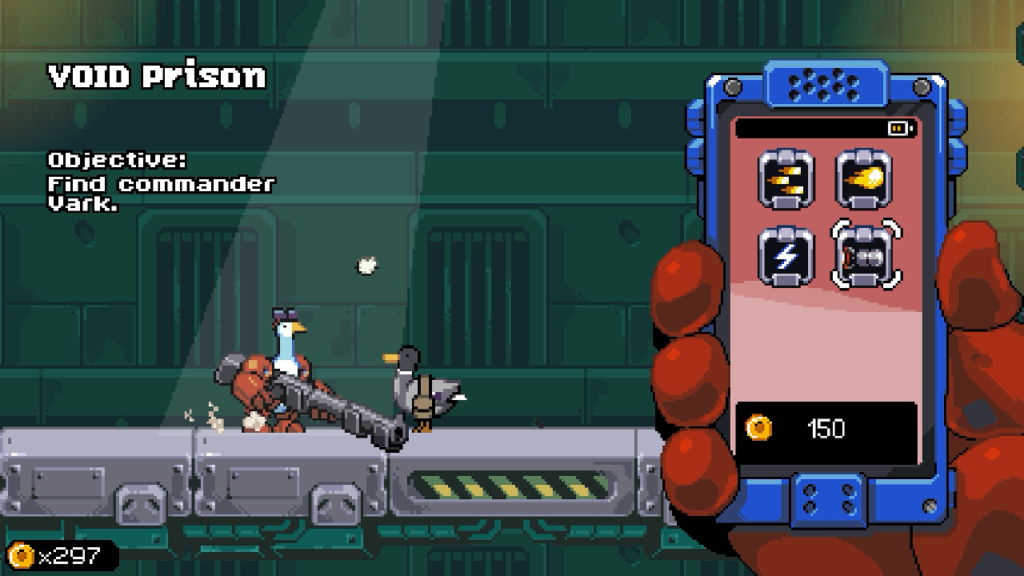
Mighty Goose is not a pure arcade experience. Each level is tackled individually. If I run out of lives then I have to start over from the beginning of the current level, not the entire campaign. Enemies drop coins which I can spend in an app on Mighty Goose’s smartphone—the pause menu—to airdrop fresh weapons into levels, though the difficulty is so slight and weapon drops so generous that not once have I taken advantage of this ability.
Between levels, I can augment Mighty Goose’s powered armor with chips that change how they perform. With the Spring Boots chip equipped, Mighty Goose moves faster. The Gun Nut chip gives more ammunition to gun pickups. The Shockwave Belt chip damages enemies around Mighty Goose when they take damage. The powered armor has a limited energy capacity and more powerful chips use more energy to equip, so I must prioritize which chips matter to my playstyle.
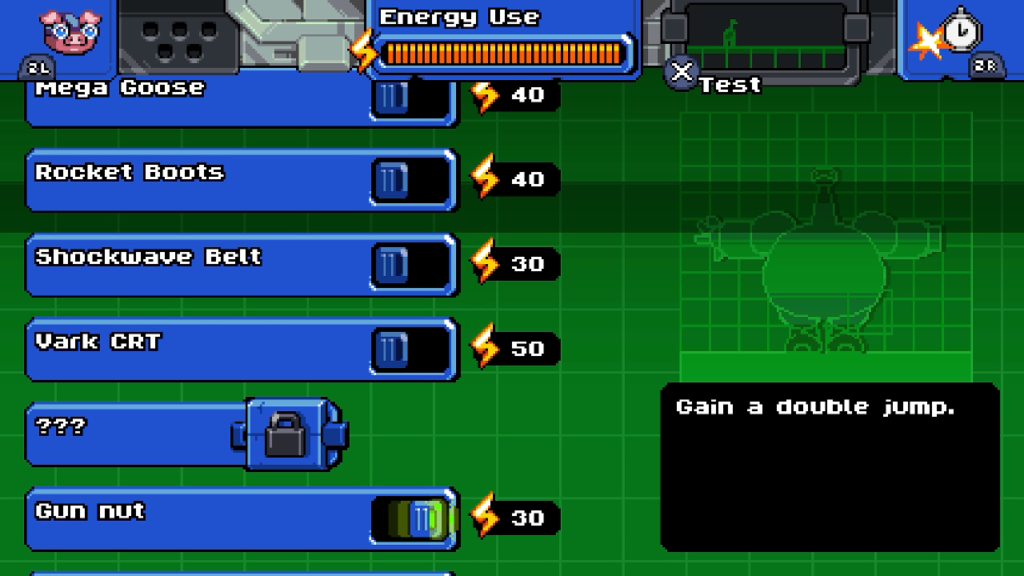
On screens adjacent to the chips I find Mighty Goose’s partners and special abilities. I can bring only one of each into a level, forcing me to make a decisive decision on which partners and abilities I want to utilize. The partner choice is simple. Each has different weapons and attack patterns and I only have to decide which is my favorite.
The abilities are more varied. Chonker Bombs roll a canister forward which explodes on contact with enemies. A Magic Hourglass slows time for several seconds. A Reflector Honk surrounds Mighty Goose with a barrier that deflects enemy projectiles. Each ability is on a short cooldown timer, ensuring I get lots of use out of them in every level. Some of them are so powerful as to break the difficulty entirely in the most wonderfully enjoyable way possible.
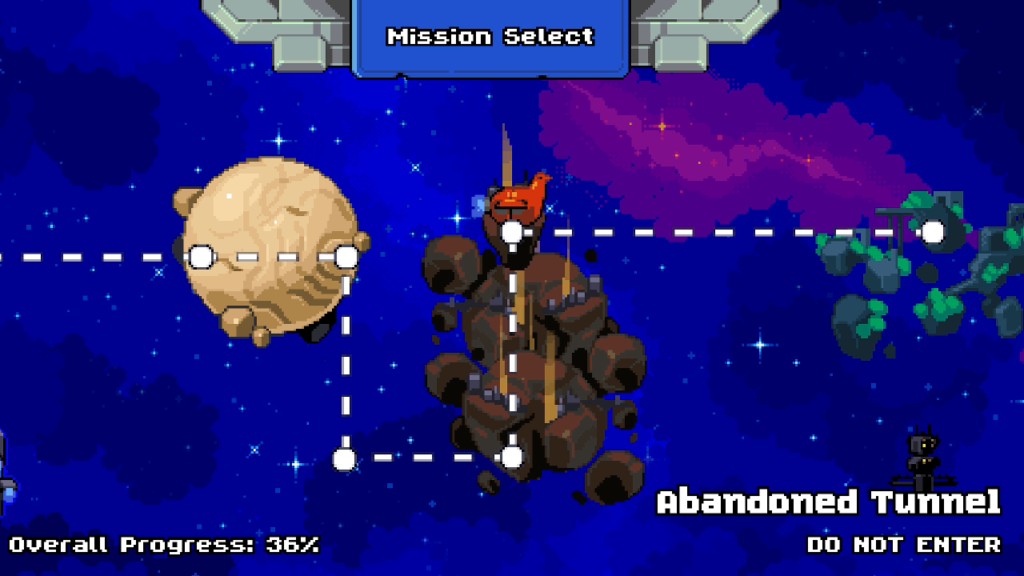
Mighty Goose travels on a massive goose-shaped space carrier across a solar system, traveling between nine separate levels. Each level implies an identity and purpose in the VOID Army’s machinations but doesn’t trouble itself with explaining these details.
The first mission finds Mighty Goose raiding a space prison to rescue Commander Vark, the team’s engineer. A later mission travels to the Bugga’veo mining facility where asteroids are drilled for precious minerals. The miners have accidentally released a swarm of parasitic bugs from one asteroid, and the VOID Army has taken an interest in the creatures. A shattered planet with a forested surface hides a source of magic power which the VOID Army seeks to tap.
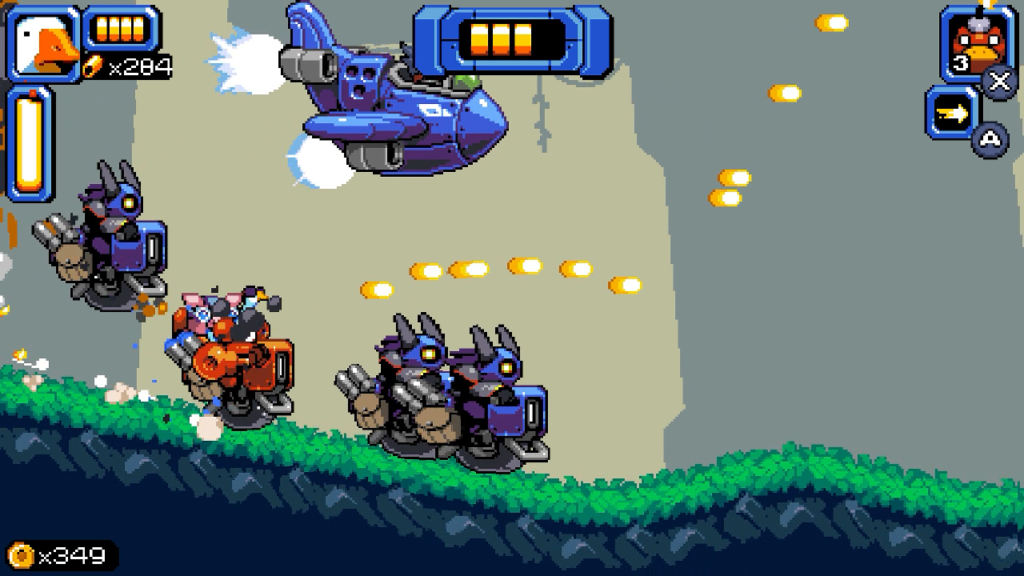
While each level shares common design elements—there’s only so much variation that can be found within run-and-gun design—the disparity of decorations, colors, and enemy types makes each level feel distinct.
The bosses that cap most levels also feel distinct, and naturally represent Mighty Goose at its most intense and challenging. Standing atop a screen-filling tank that races in front of a shimmering desert sun, I must dodge energy blasts from the tank’s telescoping scorpion tail while firing at the exposed engine beneath Mighty Goose’s feet. In the heart of a cracked asteroid, a parasite queen hovers at the top of the screen. I must risk guiding Mighty Goose beneath her gaze to target the weak spots in her mouth while dodging her frequent lunges into the ground below. In the center of the VOID Army’s forge, a bipedal tank stalks through a sea of molten metal. I must chase after it along mining tracks to shoot at its vulnerable steam core while leaping over exploding shrapnel, rolling bombs, and gaps in the track.
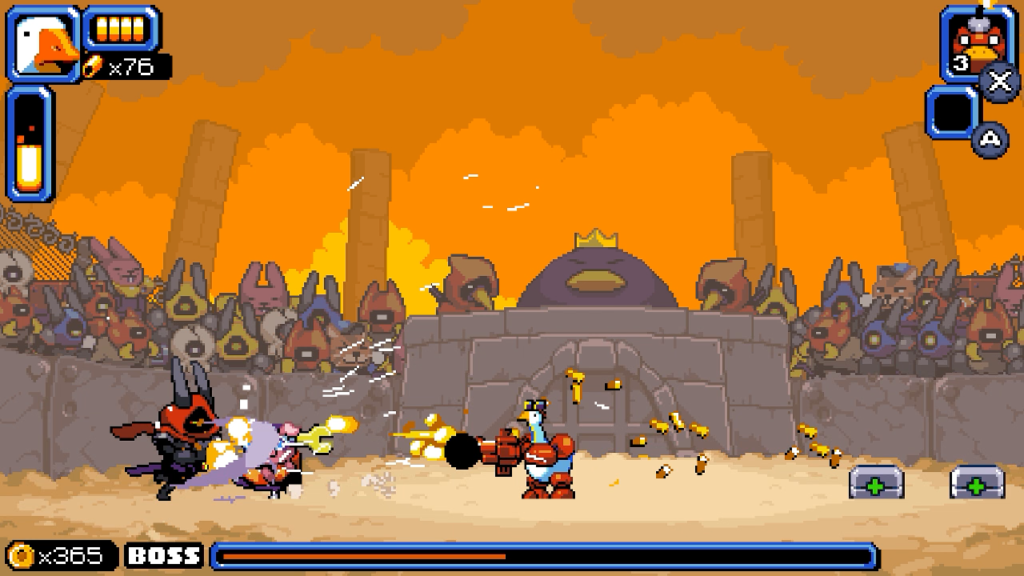
Each boss in Mighty Goose drives the pace into a frenzy of shooting and desperate dodging. They’re not all memorable, but they’re serviceable and provide the sort of challenge expected from a level-capping set piece.
When I first set out to play Mighty Goose, I found a videogame suffused with déjà vu. Even the pictures promoting the videogame seem familiar, though I was promptly distracted by the goose protagonist. Then I landed in the first mission where an excited announcer declared “Mission Start!” A short while later, I picked up a Machine Gun and the same voice exclaimed “Machine Gun!” Around the time I jumped into a tank with a swivel-mounted gun, I could not deny it any longer: Mighty Goose draws much of its design from Metal Slug.
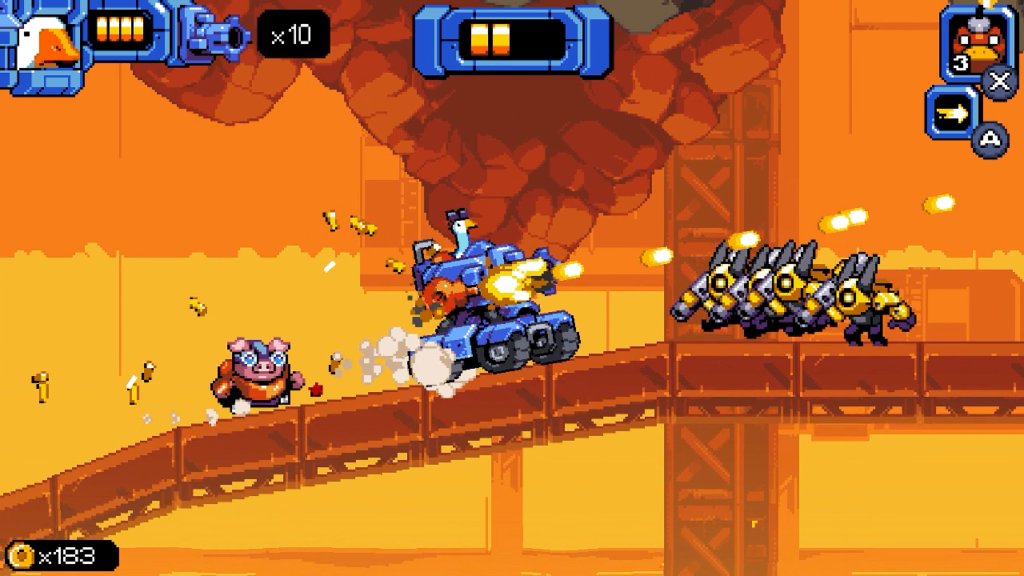
Metal Slug is a solid place to draw inspiration from. Its tough-but-fair design and beautiful animations have solidified its status as legendary among arcade shooters, even if its setting and character designs should be regarded with an arched eyebrow in a post-War on Terror world. While Mighty Goose’s reverence is clear, it still strikes out enough on its own to not feel derivative. The player character is appealing and the setting hooks me in and compels me to understand what is happening with all these bad guys I gun down indiscriminately.
Mighty Goose differs most from Metal Slug by not being driven by quarter-devouring difficulty. As a videogame originally platformed in an arcade cabinet, Metal Slug seeks to draw as many coins out of my pocket as it can. Mighty Goose is a much friendlier experience; it doesn’t want to defeat me so it can demand another coin, it wants me to see all it has to offer and have a fun time doing it. It may even go too far in its friendliness. I found the overall difficulty to be quite mild, and though there is a New Game+ with a purported higher difficulty, the partners and abilities unlocked in my first playthrough actually made New Game+ much easier to clear.
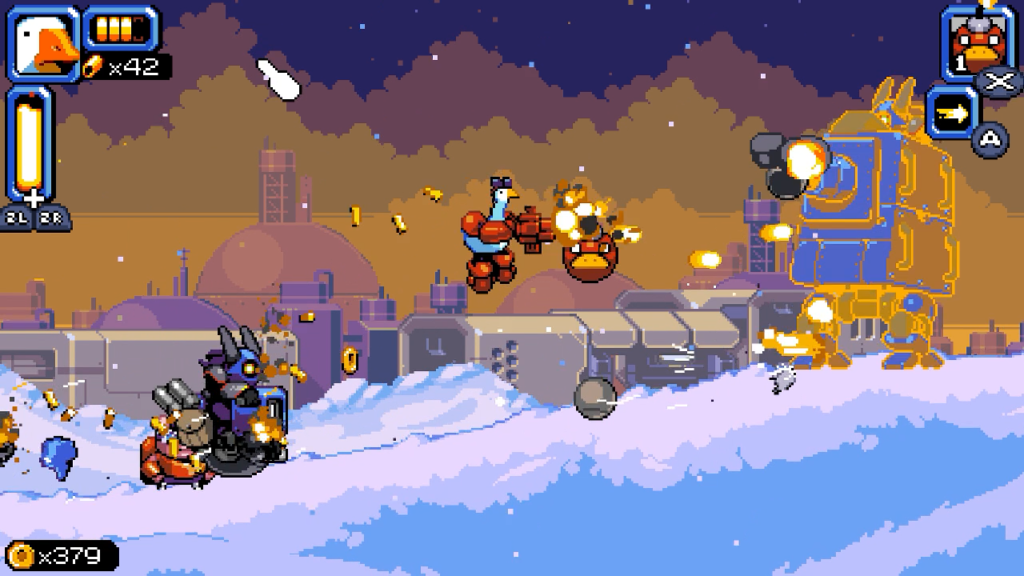
Mighty Goose is an irreverent and solidly built arcade shooter, but I find myself wishing for more. It’s an appropriately short experience—both my Standard and New Game+ clears took a little under two hours each—but the overall package seems bereft of content in its early life. Additional modes feel missing, particularly an Arcade mode where I must beat the entire game in a single life, an egregious absence in an arcade shooter. It’s possible these modes may come in later updates, but I cannot say for sure. Despite these apparent holes, I enjoyed my time with Mighty Goose. Its characters and gunplay are fun, the setting is interesting, and it chooses a worthy predecessor to serve as its base. It’s a solid, if short-lived choice for arcade shooter fans.